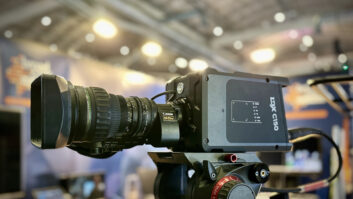
Ahead of NAB 2016, TVBEurope asked a number of industry leaders for their views on the progress of the broadcast and video technology industry, and the talking points at this year’s show that will best inform us about the evolution of our marketplace. The IABM’s Stan Moote opens the discussion.
At the NAB Show, press, attendees and exhibitors always want to see, hear and promote the next technology that will dominate. The first question on everyone’s lips is always ‘what did you see?’ ‘what is new here?’ This used to be simple to answer; the switch to stereo – then surround sound, analogue to digital to HD, linear to non-linear file-based editing, visual effects and the switch from huge cameras/lenses to hand-held combos and miniature go-anywhere cameras to name but a few.
Our industry has exploded on the technology curve over the past decade; however, I must say that, as an industry, we are very slow to change workflows and infrastructure. On the acquisition/production side, everyone is excited to try out new approaches, equipment and almost anything that will give them an edge over the competition, whether it is a unique production tool or a dramatic cost saving endeavour. On the facility/delivery side, though, resistance to change has meant this sector has been very much in catch-up for the past couple of years. For most businesses, global internet access is changing everything quickly. We all know this of course – the problem many are wrestling with is how to blend this with current business models.
This is exactly why NAB 2016 is an essential year to attend. Not because there will be one special technology or trend revealed, but because there are so many new approaches to the business; engineers, visionaries and executives all need to have a clear understanding to move forward. Gone are the days of ‘wait and see what happens’.
Cord-cutting has renewed interest in terrestrial broadcasting which, with ATSC3.0 and DVB-T2 delivery supporting hybrid approaches, will grow in attraction. This directly ties into spectrum issues like repack and how stations are revamping for the future.
Over the last year or so, a new word has entered the industry’s vocabulary – Recommendation. This is a key factor for the new breed of over-the-internet media operations. Today it’s not just about making and offering great content, but also working to keep consumers tied to your channel by flagging up content that suits their viewing habits.
On the acquisition side, point-of-view cameras, high resolution capture and drones continue to improve every year and are becoming a must-have, but in the case of the last item, not necessarily in close proximity to an airfield!
Technology issues such as HDR, wider colour gamut, the shift to in-plant IP, the cloud and UHD/4K will be ever-present at NAB; they are becoming the norm that everyone needs to understand and not shy away from. Various organisations are working together to move standardisation forward quickly in these areas; expect to see progress on this at the show – but not necessarily in directions that will make everyone happy all of the time!
This NAB won’t focus on digital media, social media and new media as orphans. They are still often thought of as a thorn in the broadcaster’s side: must have – need budget – near profitless. However, consumers expect and demand these second, third and even fourth screen experiences alongside their first screen viewing and handled correctly, should be seen as gain-not-pain. At NAB, expect to see new techniques and technologies for seamlessly integrating these rapidly maturing ‘new’ channels into production and delivery workflows.
The biggest elephant in the room at NAB will definitely be Virtual Reality. VR is cool stuff. I have seen demos and you can feel like you are right in the middle of a riot. Beyond gaming, medical and industrial applications, the technology is looking for a home in broadcast, movies and sports. Whether consumers can – or indeed want to – spend their time continually shut off from the real world around them though remains to be seen; 3D was supposed to be a no-brainer because it was so immersive, right? So was it the glasses that did for it? And will the VR headset ultimately meet the same fate for television? How do you use a second screen with a headset on? The jury is currently out, but I’m optimistic that the NAB Show helps us see VR’s future more clearly.






